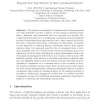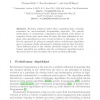50 search results - page 8 / 10 » Applicability of genetic algorithms to reconstruction of pro... |
TMI
2008
13 years 7 months ago
2008
With continuing improvements in spatial resolution of positron emission tomography (PET) scanners, small patient movements during PET imaging become a significant source of resolut...
3DPVT
2004
IEEE
13 years 11 months ago
2004
IEEE
Abstract-General information about a class of objects, such as human faces or teeth, can help to solve the otherwise ill-posed problem of reconstructing a complete surface from spa...
ISBRA
2010
Springer
13 years 5 months ago
2010
Springer
The random accumulation of variations in the human genome over time implicitly encodes a history of how human populations have arisen, dispersed, and intermixed since we emerged as...
UPP
2004
Springer
14 years 20 days ago
2004
Springer
Evolving solutions rather than computing them certainly represents an unconventional programming approach. The general methodology of evolutionary computation has already been know...
STOC
2006
ACM
14 years 7 months ago
2006
ACM
One of the major tasks of evolutionary biology is the reconstruction of phylogenetic trees from molecular data. The evolutionary model is given by a Markov chain on the true evolu...


